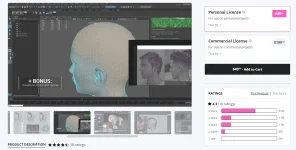
Creating realistic hair for 3D characters is one of the most challenging tasks in digital art and animation. It requires an understanding of advanced modeling techniques, texturing, and the intricacies of shaders and lighting. Whether you’re an experienced artist or a beginner looking to level up your skills, the Real-Time Hair Tutorial by FlippedNormals offers an excellent resource to help you master this critical aspect of 3D design.
Why Hair Creation is a Challenge in 3D Art
Hair in 3D design is difficult to master because it’s not just about creating strands that look realistic, but also about simulating how light interacts with hair and how hair behaves naturally in the real world. Artists need to focus on various technical and artistic components, including:- Shading and Lighting: Hair should have a unique reflective quality that makes it look believable under different lighting conditions.
- Strand Modeling: Each hair strand must be shaped and rendered in such a way that it feels like part of a living organism, while maintaining artistic intention.
- Dynamics and Movement: Hair moves and flows in response to environmental factors, and simulating that movement in real-time requires understanding physics simulations.
What Does the Real-Time Hair Tutorial Cover?
The Real-Time Hair Tutorial provides a comprehensive walkthrough of creating realistic hair in 3D, focusing on key techniques, tools, and software commonly used in professional 3D modeling workflows. Some of the core areas covered in this tutorial include:- Modeling Hair Strands: The tutorial goes into detail on how to model individual hair strands, making sure they have the right texture, flexibility, and realism. It covers the tools needed for strand manipulation and how to control hair thickness, length, and other properties.
- Texturing and Shading: One of the most important aspects of making hair look realistic is creating the right textures and shaders. The tutorial walks you through creating custom textures for hair, including techniques for generating natural-looking highlights and shadows.
- Lighting for Realistic Hair: Understanding how hair reflects and refracts light is crucial. This section of the tutorial dives into different lighting setups and how to adjust them to enhance the realism of the hair you create.
- Using Hair Simulation Software: The tutorial utilizes industry-standard hair simulation software, such as XGen in Maya or Blender, allowing users to apply real-time simulations for realistic movement and flow. By following the tutorial, users can create hair that responds dynamically to wind, movement, or other environmental factors.
- Optimization for Real-Time Rendering: For game developers and animators working with real-time engines like Unreal Engine or Unity, the tutorial provides tips on how to optimize hair for smooth performance without sacrificing visual quality.
- Practical Tips and Tricks: Throughout the tutorial, FlippedNormals offers valuable tips for troubleshooting common problems, such as texture stretching, shading issues, or incorrect strand placement. These insights are invaluable for artists looking to refine their technique and streamline their workflow.
Who Is This Tutorial For?
The Real-Time Hair Tutorial is perfect for 3D artists and animators at all levels who want to learn how to create hair that looks realistic in both still images and animations. Whether you are:- Beginners: If you're new to 3D modeling, this tutorial will help you understand the foundational techniques for creating hair, including how to work with various tools and settings.
- Intermediate Artists: Artists with some experience in 3D modeling can take their hair creation skills to the next level by mastering advanced texturing and shading techniques.
- Professionals: Experienced 3D artists working on high-level projects such as character modeling for games or films can refine their skills in real-time hair simulation and rendering.
Why Choose FlippedNormals?
FlippedNormals is a trusted platform for professional-level tutorials. Their Real-Time Hair Tutorial stands out due to its clear instruction, comprehensive content, and practical application of industry-standard tools. The tutorial is well-structured, making it easy to follow, and offers lifetime access, so you can revisit the material anytime you need a refresher or want to delve deeper into specific techniques.Final Thoughts
Mastering hair creation in 3D design requires dedication, but with the right guidance, it’s achievable. The Real-Time Hair Tutorial by FlippedNormals equips you with all the tools, tips, and techniques you need to create photorealistic hair for your 3D models. Whether you're creating characters for films, games, or virtual environments, this tutorial can elevate the realism of your work, enabling you to push the boundaries of what’s possible in 3D art.
Last edited:

